Fri 11 Jul 2014
GIRL ON THE RUN. Astor Pictures, 1953. Richard Coogan, Rosemary Pettit, Frank Albertson, Harry Bannister, Edith King, Charles Bolender, Renee De Milo. Directors: Arthur J. Beckhard & Joseph Lee.
I didn’t mention him in the credits above, since he was onscreen all of five to ten seconds, but one of the reasons this film may even have survived today is that Girl on the Run is known to be the first screen appearance of Steve McQueen. He’s a guy trying to show off his strength to his girl friend, trying to ring the bell at a carnival game. (I’ll have to watch the movie again. I’m told that he appears again later, again very briefly, walking around the midway with his arm around the girl.)
But the star of the film, Richard Coogan, is almost as well known, but only if you grew up watching Captain Video in the late 1940s — Coogan being the first actor to play the title role. And please note, title of the film to the contrary, he’s the one who’s actually on the run. He’s a reporter accused of the murder he didn’t commit, that of his boss, the newspaper editor who was getting too close to a vice ring working in and around a local carnival.
Not to say that the title is completely wrong. Coogan’s girl friend, played by Rosemary Pettit, is on the run with him — she’s a witness who could clear him. Their refuge is at the carnival where the entire movie takes place, where they also hope to find the person really responsible for the editor’s death.
So we get to see a lot of what goes on behind the scenes, in the dark passageways between and behind the concession booths and the various games of chance. And the hootchy-kootchy tent. Every carnival in the 1950s had one, including the one that came to my small town in upper Michigan every fall when I was a lad.
What wonders lay behind the curtained gateway I (and my friends) could only imagine.
I learned a new word watching Jeopardy, the TV game show, this week. It’s “Rubenesque,” which is a polite way (I think) of saying that what hidden delights lay behind that curtained door in Michigan are (I suspect) the same as are revealed in Girl on the Run.
I will not pursue this thought further — you may, of course, use your own imagination — but one exception to the rest of the ladies and their tired and somewhat weary dance routines is the presence of Renee De Milo, whose first and last film appearance this was. I hope to add a photo of the lady. (And I have, as you can plainly see, below.)
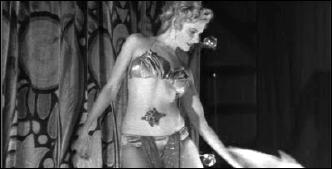
The movie is surprisingly fun to watch, much better than it had any right to be. Shot on a low budget and in an exceedingly cramped location, the production values are on a par of what passed for TV drama in 1953. Nonetheless, what’s also seen is the best of what noir films can display, in pure black and white imagery, with a cast of semi-stars (at best) and extras that fit one’s concepts of carney life to perfection.
The story itself isn’t much. It is little more than a tease and an excuse. Maybe if you enter hoping only to see the dancing girls will you get your money’s worth, but once inside, you’ll see more than you expect, and no, that isn’t what I mean.
While the link lasts, you may watch the entire movie online here.
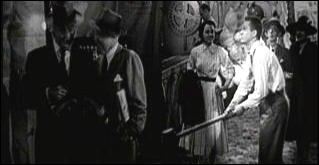
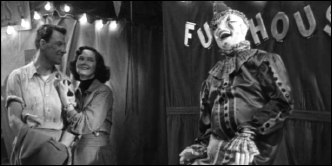
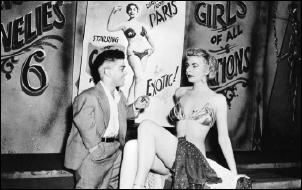
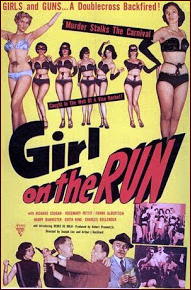
July 12th, 2014 at 12:06 am
I was pleasantly surprised when I watched this film noir a couple months ago. It’s in the dvd box set titled WEIRD NOIR. It’s certainly weird alright and captures the Carny atmosphere. I was impressed by the girls in the dancing act, sort of seedy, overweight, tired looking, but sexy also with the masks.
After watching it, Scott Hartshorn and I viewed it again a couple days later and being a fellow film noir lover, he was impressed also. A bizarre and unusual low budget movie.
July 12th, 2014 at 5:44 am
You make it sound fascinating!
July 12th, 2014 at 5:31 pm
I too watched it in the Weird Noir set (all six of the films included are HIGHLY worth watching). Let me quote my IMDB review:
One of several worthy discoveries in Something Weird Video’s “Weird Noir” set, and the most formally interesting of the bunch. “Girl on the Run” obeys the classical unities of action (one plot, which is all you have time for in 64 minutes), time (it all takes place in one evening), and place (it is set entirely inside a traveling carnival’s grounds). The film is spatially fascinating: you really get a sense of how a carnival can pack a lot of activities into a smallish area, and how, out of direct sight of the public, the “inner world” of the carnival company can go on vigorously despite there being no apparent physical room for it. The sound design is dense and realistic and lends a high degree of verisimilitude to the film’s texture.
“Girl on the Run” is bookended by an excellent night-time opening shot of the carnival and its Ferris wheel from a medium distance, very atmospheric, and a great closing shot of a laughing mechanical clown. Some thought went into the presentation here.
On the debit side, the acting is fairly ordinary, although protagonist Richard Coogan – television’s first Captain Video – is certainly a handsome, energetic chap. The storyline is nothing special either. And yet the very standardness of these elements throws the more innovative aspects of the movie into higher relief, and the overall result is highly watchable.
I encourage any film history student or scholar looking for an offbeat candidate for detailed analysis to take a look at this movie; I think you might see rich possibilities in it.
July 12th, 2014 at 5:33 pm
A fine review, Patrick, and I hope someone takes you up on your last paragraph!
July 12th, 2014 at 7:20 pm
“Rubensesque” refers to women who might variously be described as “full-figured gals” (as Jane Russell used to say in her Playtex commercials) or “zaftig” (as many of our grandmothers used to say). Just look at some of Rubens’s paintings. His wife, and frequent model, has 62-inch hips, if that gives you any idea of his ideal woman.
July 12th, 2014 at 8:18 pm
62 inches? I guess I may have exaggerated some, just a little.
July 13th, 2014 at 8:25 am
Steve,
I just watched this movie last week after getting the WEIRD NOIR collection in the mail. I knew McQueen was in it, but completely missed him (twice after reading your review). I completely enjoyed the Hoochie Koochie girls and especially the Main attraction! I also thought it was unique having the carnival run by a midget, who tried to put the move on the girl hiding out! Anyone reading this review, I recommend buying the Weird Noir collection. I’ve only watched one more as yet but “The Naked Road” must be seen! A sex hungry model photographer tries to put the moves on his teenage hiree and when she declines he’s stopped for speeding on his way to drop her off home. He then must leave her for collateral at a corrupt Judge’s office while he goes home to get the cash to pay the fine. What happens to the girl after that is a degenerates delight! This movie is right out of a nightmare!! I can’t wait to see the other four in the collection.
July 13th, 2014 at 10:46 am
I saw “The Naked Road” also Paul and I found myself gleefully cackling at some of the scenes. Some film noirs and crime films are indeed a degenerate’s delight. I guess that’s why the boxset is called WEIRD NOIR.
July 13th, 2014 at 1:30 pm
Walker,
I plan on watching the other four movies before our trek to Pulpfest.
It should be fun to talk about these films on our way out!
Steve, you’ll have to review all the films in this set.
July 13th, 2014 at 2:04 pm
I have the set you guys are talking about, but I’ll have to locate it before I can review the other films that are in it. You certainly have me interested. The copy of GIRL ON THE RUN I watched was a singleton DVD from (I think) oldies.com
July 13th, 2014 at 9:29 pm
Have to look this one up since carny movies are a minor obsession. Sounds like something different.
Rubenesque goes well beyond zaftig. Rubenesque is Rosanne Barr country. This looks more like ample pulchritude. But then remember beautiful women had fuller figures then ala Diana Dors, MM, Jayne Mansfield, and Anita Ekberg. They just looked like well built girls to viewers at the time.